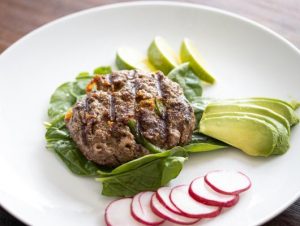
Jalapeno Burgers. A spin to our beloved burgers.
Imagine, a juicy, succulent and cooked to perfection beef patty with chunks of cheddar cheese weaved inside and out. The perfect amount of heat from the jalapeno. Savory and super delicious.
At CWEB, we are always looking to expand our network of strategic investors and partners. If you're interested in exploring investment opportunities or discussing potential partnerships and serious inquiries. Contact: jacque@cweb.com

Jalapeno Burgers. A spin to our beloved burgers.
Imagine, a juicy, succulent and cooked to perfection beef patty with chunks of cheddar cheese weaved inside and out. The perfect amount of heat from the jalapeno. Savory and super delicious.
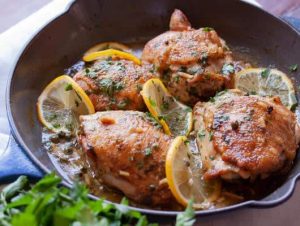
A classic dish with a twist, brandy. I should follow my own rule of always having all the ingredients on hands, and tonight somehow we did not have any white wine at the house. Plenty of red, that for sure, but white, not a bottle in sight. I had to come up with something on the spot, therefore, I decided to use brandy instead of white wine. It was delicious!
The brandy with chicken broth, garlic, capers, and lemon juice was just out of this world. A richer texture and the last piece of butter made it all bind well together. I love it better than the original classic and look forward to preparing it again.

Sugar meets butter and just like that you have this perfectly crisp cookies. Add another touch of sugar on the outside and then you will never be the same.
Those cookies were a lot of fun to put together and my son has not stopped eating them. I have helped too just in case you were wondering.
Ingredients
1 cup unsalted butter, softened
1 1/2 cup firmly packed dark brown sugar
1 large egg
1 teaspoon vanilla extract
3 1/3 cups all-purpose flour
1 teaspoon baking soda
1/2 teaspoon salt
decorator sugar crystals
Preparation
1 Beat butter at medium speed with an electric mixer until creamy. Gradually add brown sugar, beating well. Add egg and vanilla and continue beating.
2 Combine flour, soda, and salt. Add to butter mixture little at the time and beating until well blended.
3 Preheat oven to 350F.
4 Roll dough to ¼ inch thickened between 2 sheets of wax or parchment paper. Cut into favorite shape, stars for me. Place 1 inch apart on ungreased baking sheets. Sprinkle cookies with decorator crystals.
5 Bake for 10 to 12 minutes or until golden. Let cookies cool on baking sheet for a minute. Transfer carefully to a wire rack to cool completely.
Source Foodista Giangi Townsend
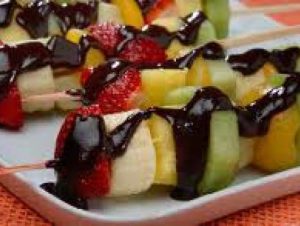
Delicious, ripe fruit covered in Healthy Dark Chocolate is a heart healthy treat you will be proud to serve at your next BBQ!
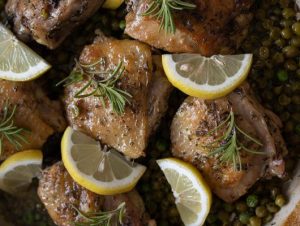
Rosemary, Peas, Lemon Chicken. Juicy tender rosemary chicken paired with the tanginess of the lemon and the sweetness of the peas, a perfect weeknight meal.
Not having white wine on hand, I choose to create this dish with brandy. As we all know, brandy is just the perfect replacement for wine and one that is one of my favorite choices.

Comfort food is all I want lately. Shrimps and Grits are just that for me. Creamy soft grits with a medley of soft vegetables over it. Tender shrimps with a perfect sauce to go along. Here is my creation.
I had some vegetables in my crisper, and I wanted to enjoy them before it would be too late.
A couple of personal notes about this recipe: I did not use salt with the grits because the Parmesan cheese is a bit salty in itself, and adding salt would make it too saltier. Make sure you let the butter melt with the grits before adding the parmesan cheese. If the grits become too thick and lose the velvety, creamy feeling, add a bit of more milk.
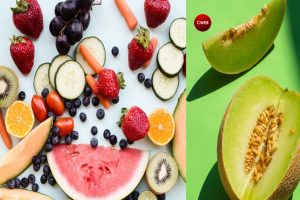
One of the interesting things about vegetables and fruits is that they’re still alive when you’re storing them. In fact, unless you cook them, they’re still alive when you eat them. Raw food vegans had better be quite comfortable with their life choices knowing the sheer number of living beings that they consume just to live. I’m not judging, I merely mention because it’s just occurred to me.
The problem with the plants being alive is that they continue doing whatever it is that they would normally do under the circumstances. In some cases this means turning sugars into starches, in others starches to sugars. Colors may fade, cells might degrade. Life goes on.
Bananas for example are all well and good as a fresh fruit, but while they’re green, they’re tasteless, and only as the continue to age do they turn starches into sugars. Leave them out for to too many days and they become brown and generally unappealing. Of course when they get brown and mushy bananas are perfect for banana bread.
Sometimes you’ll slow down the living processes by reducing the molecular activity by slowing down all of the molecules. Though this sounds complex, I’m really just talking about putting something in the refrigerator or freezer. After all, temperature is just the average speed of molecules in any given substance, so to slow down chemical processes, you make it colder.
Freezing is much more effective at slowing the processes than cooling, but that doesn’t make it a good idea in all cases. After all, freezing will create ice crystals in the cells, and as they expend it will rip through the membranes and cell walls of your plant which will cause the cells to leak upon thawing. This is fine in some cases but not in others, so use caution with the freezing. A general rule is that if you don’t see it in the freezer aisle it probably doesn’t freeze well.
Another useful rule is for whether to refrigerate a fruit or vegetable. The the plant in question lives in through cold weather. If it’s a tropical plant,it would be happier on the counter because the plants are still alive.
There are times when you really want to stop whatever’s going on within the plant, and that usually means halting enzymatic actions. Enzymes are proteins that facilitate chemical reactions and are one of the lower-level functions of a living system. If you can stop the enzymes from doing their thing, then you can stop the aging process. They way to do that is with heat.
Of course, heating food is one way to cook it and there are all sorts of other chemical processes that go on when you cook food. You might just want to stop the enzymatic stuff without seriously damaging the fresh taste or texture of a food. At this point, you’re looking at a blanch.
Blanching is cooking something for a brief amount of time and then halting the cooking process quickly. Traditionally, this is done by briefly putting it into boiling water then transferring the food to cold water. If you’re French, it would be ice water, but room temperature water will do just about as well. You only need to change the temperature quickly, you don’t need to freeze the food, and water’s heat transfer ability will work nearly as well at room temperature as it will at the freezing point.
If you’re cooking a green vegetable, you may also take advantage of the blanching process to reduce the acidity a bit with some baking soda into the boiling water. This will brighten up your greens. If it’s a purplish vegetable you do not want to do this unless you want your vegetable to turn bright green. You could enhance the reddish-purple color by adding some acid.
Another trick for blanching is to allow the use certain tropical fruits in gelatin dishes. Papaya, mango, and pineapple all have enzymes that break down certain connective tissues in meat. Because gelatin is based on a connective tissue, collagen, the enzymes in those fruits will break down the gelatin, thus taking what should be a nice mould and turning it into a sweet, sticky puddle with some fruit at the bottom.
As we know that blanching will stop enzymatic processes. Blanching the fruits before putting them into the gelatin.stops enzyme actions which can cause loss of flavor, color and texture.